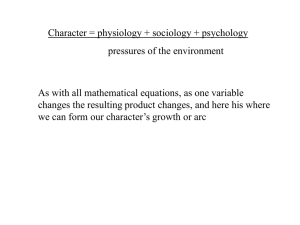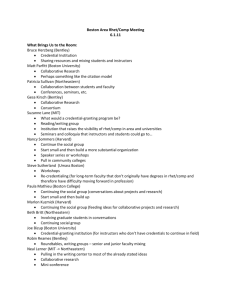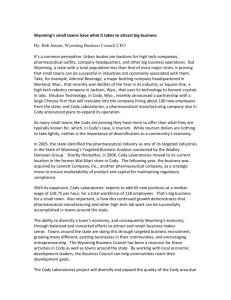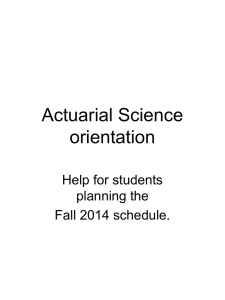Rasky_Kratz_Thompson_Hamilton
advertisement
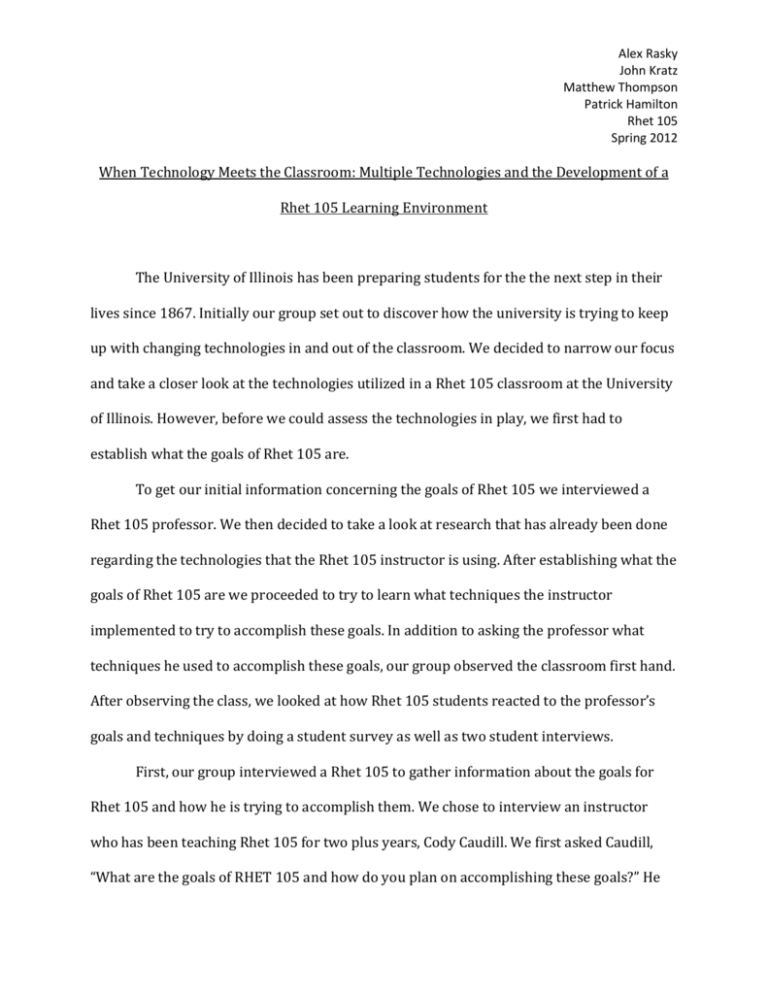
Alex Rasky John Kratz Matthew Thompson Patrick Hamilton Rhet 105 Spring 2012 When Technology Meets the Classroom: Multiple Technologies and the Development of a Rhet 105 Learning Environment The University of Illinois has been preparing students for the the next step in their lives since 1867. Initially our group set out to discover how the university is trying to keep up with changing technologies in and out of the classroom. We decided to narrow our focus and take a closer look at the technologies utilized in a Rhet 105 classroom at the University of Illinois. However, before we could assess the technologies in play, we first had to establish what the goals of Rhet 105 are. To get our initial information concerning the goals of Rhet 105 we interviewed a Rhet 105 professor. We then decided to take a look at research that has already been done regarding the technologies that the Rhet 105 instructor is using. After establishing what the goals of Rhet 105 are we proceeded to try to learn what techniques the instructor implemented to try to accomplish these goals. In addition to asking the professor what techniques he used to accomplish these goals, our group observed the classroom first hand. After observing the class, we looked at how Rhet 105 students reacted to the professor’s goals and techniques by doing a student survey as well as two student interviews. First, our group interviewed a Rhet 105 to gather information about the goals for Rhet 105 and how he is trying to accomplish them. We chose to interview an instructor who has been teaching Rhet 105 for two plus years, Cody Caudill. We first asked Caudill, “What are the goals of RHET 105 and how do you plan on accomplishing these goals?” He Alex Rasky John Kratz Matthew Thompson Patrick Hamilton Rhet 105 Spring 2012 responded by saying, “The primary goal that I have is to, first and foremost, invite students to follow a passion.” He also said, “Another goal is to show students that there is no such thing as ‘writing in general.’” Caudill tries to provide his students with useful information, and then let them choose how to use that information. In his class students are allowed to choose a research topic, instead of forcing students to write about a specific topic. This helps students stay motivated throughout the semester, because they have control over what their researching rather than being forced to research a topic that does not interest them. After discovering what goals Caudill has for his Rhet 105 class we wanted to understand how he accomplished them. He said, “Well, first and foremost it is accomplished through open communication with peers and reflection on our successes and failures as a group.” One method Caudill uses to foster open communication between students is a website called Tumblr. Tumblr is a blogging site that Cody uses to allow students to connect with one another outside of the classroom. Each week the students post to Tumblr, and since these students have access to each others work, they can openly critique it in a positive manner. In addition, Cody updates Tumblr on weekly basis to let students know what the weekly assignment is. Essentially, Cody uses Tumblr as message board where students can stay up to date regarding their assignments and any changes that are made to them. However, the message board also helped students connect with one another for several reasons. One, students were able to analyse each others work in a positive way. Second, students were also allowed to post about anything they wanted, Alex Rasky John Kratz Matthew Thompson Patrick Hamilton Rhet 105 Spring 2012 including topics regarding things outside the classroom. This aspect of freedom allowed students to feel more connected to one another. Cody said, “Students learn best when the entire class feels comfortable to contribute to our larger goals.” This means having open communication makes everyone more comfortable critiquing each others work. This allows the class to accomplish greater goals. However, Tumblr is not the only tool that Caudill uses to keep his class connected with each other. In Caudill’s classroom, there are TV monitors arranged throughout the room, as well as a projector in the center. These monitors and projectors have the capability to show the same image on all screens, allowing all students get a good angle at the image. The monitors also allow for students to plug in their laptops, so that they can project their work for the rest of the class. Caudill uses this feature for group to revise each others work. The students often get into small groups around the monitors and take turns critiquing each others work. Cody states, “I don't ever want to be the only expert in the room.” By allowing for students to critique each other's work, Cody gives students the opportunity to learn by teaching. Another unique facet of the classroom are the mobile desks and chairs. Without the mobility of the desks and chairs, the monitors surrounding the classroom would be ineffective because the groups would not be able to collaborate as effectively. Since Rhet 105 often has people present to the class, the mobile desks can be moved from a group formation to a horseshoe formation that focuses the attention of the students on the speaker. The flexibility that this classroom provides is essential in accomplishing the goals Alex Rasky John Kratz Matthew Thompson Patrick Hamilton Rhet 105 Spring 2012 set out by Caudill. An average classroom on campus which consists of stationary desks, adds constraints to the learning atmosphere. Or group found this article about technology in the classroom. The research was titled “Educational use of social networking technology in higher education.” This article was published in an academic journal called Teaching in Higher Education. In this study students used a social networking site to discuss coursework. This article discussed the advantages of using social media sites in classrooms and how they affect student progress. It also says that classes that used social media sites in addition to normal classroom learning developed communities of practice. This article defines communities of practice as “a specific type of psychological community based on the following characteristics: (a) the setting is the world of education; (b) the primary purpose is learning; and (c) the community is based on a fixed organizational tenure, that is, a set length of the course or program in which members are enrolled” (Hung, 704). These students felt it was easier for them to share ideas and information with each other when they were connected through social media sites. This supports Caudill’s belief that students learn better when they feel more connected to their classmates. Students in Caudill’s class begin to form a community when they are helping each other reach a common goal. In this case, the goal is for students to help each other become better writers through writing and revision. The community that is built in the classroom is able to expand with the use of social media. Learning is now possible outside the classroom which creates a thicker bond between students. Alex Rasky John Kratz Matthew Thompson Patrick Hamilton Rhet 105 Spring 2012 We also found another secondary source that pertained to the advancement of learning inside and out of the classroom. The article that we read was titled “iTunes university and the classroom: Can podcasts replace professors?” The piece was taken out of a journal called Computers and Education. This article talked about the uses of podcasts as a replacement for going to lecture. The students who participated in the experiment were divided into two groups. The first group was given lecture slides before class and was told to go to lecture. The second group was given the lecture slides, but instead of attending lecture the group was given a podcast of the lecture. The results of this experiment were quite surprising. The results showed that the students who listened to the podcasts scored on average ten percent better than the students went to lecture (McKinney). This shows that when students are given more resources they often use them to their advantage. When asked about the future of podcasts in education Cody replied, “So much learning happens out of the classroom and videos and podcasts are an emerging way this happens.” Cody often posts videos on Tumblr that supplement class work. The more students are exposed to the material the better they will learn it. With a limited amount of class time instructors often struggle to present all coursework in lecture and students are often forced to learn certain concepts on their own. The podcasts and videos allow the professor to engage with the students when they are not in the classroom setting. This is also more convenient for the student because he or she has the ability to learn at their convenience. Alex Rasky John Kratz Matthew Thompson Patrick Hamilton Rhet 105 Spring 2012 Cody often uses videos to introduce new topics prior to class, so students are somewhat familiar with the topics that will be discussed in lecture. This allows for Cody to be more efficient with his time in the classroom. He is able to avoid the introductions and jump right into the material. Using videos and podcasts not only helps students learn outside of the classroom, but it also enhances their learning experience in the classroom. Caudill said, “I think they [podcasts and videos] should be viewed as additional resources for students to access information. Expanding access is never a bad thing.” This builds upon the idea that podcasts and videos shouldn’t replace what a teacher has to offer, but it should expand on and improve what a class has to offer. The third article we looked at was called “Read-only participants: a case for student communication in online classes.” It was published in a journal titled Interactive Learning Environments. This article is about a masters class the uses and online discussion board. It was optional to view and post on the board. The researchers recorded every time a student looked at the board and made a post. They also observed how collaborative each student was while working on group projects. The results showed that the students who viewed the site most often got the best grades (Nagel). The students in this survey were broken up into three groups: fail, pass, distinction. The students who failed visited the site an average of 771.5 times, the pass group 1278.7 times and the distinction group 1666.2 times (Nagel, 43). The students were also rated on their collaboration with others. The students were rated on a one to ten scale. Students who used the site most often had significantly higher collaboration scores than those who did not. The students who received higher grades also Alex Rasky John Kratz Matthew Thompson Patrick Hamilton Rhet 105 Spring 2012 posted significantly more than did the students who did not. These results indicate that online message boards help students succeed. Cody uses Tumblr (blogs) to keep students engaged in the material of his course. This article supports Caudill’s theory that the more students are engaged, the better they learn. That is why the students have the freedom to post about things unrelated to course material on their blogs. Students are still engaging and connecting with others even though they are not specifically talking about their course work. It also goes along with the idea of podcasts being useful in addition to the classroom. When students stay engaged in course material inside and outside the classroom their grades will often improve. These secondary sources helped us get a grasp on innovations and studies being made outside of our University. We wanted to take a look at how Rhet 105 students at the University of Illinois are reacting to changes being made in their learning environments. We interviewed two of Caudill’s students and asked them a series of questions regarding their sentiments towards the teaching methods used by Caudill. We interviewed William Harvard, who is a freshman student in one of Caudill’s Rhet 105 classes. We started by asking William whether he felt the use of social media in their class helped him get connected with other classmates. He responded, “yeah, the fact that I’m connected with over over ten of my classmates over Tumblr makes it easy for me to check out other peoples work, and discuss it when we get to class (Harvard interview)”. This statement supports Caudill’s belief that students will feel more connected with one another if they can connect outside of the classroom. If students don’t choose to follow Alex Rasky John Kratz Matthew Thompson Patrick Hamilton Rhet 105 Spring 2012 each others pages, this resource is not fully utilized and does not help accomplish all of the goals that Cody is trying to achieve. One of Caudill’s main goals is to create a class setting where students are comfortable with each other, and he isn’t the only person teaching. By following other students on Tumblr, students are able to consistently learn from each other. After analyzing the classroom connection that Caudill looks to achieve through Tumblr, we wanted to ask William how Tumblr effects the coursework of the class. William commented on the its effects, “I think Tumblr’s main attribute to the class is that it makes each assignment very easy to access. Caudill posts every assignment on Tumblr and then we respond on our page it’s very simple (Harvard interview)”. Caudill connects with all of his students on Tumblr so that he can post an assignment and it will show up on the students main page. “The new technology used in this class make it easier to stay on top of coursework compared to other classes where you have to follow a syllabus that is made way too far in advance. Usually these syllabus’ need a lot of revision which is difficult to stay up to date with (Harvard interview)”. This seems to help the class be more organized. Freshman often have a hard time transitioning to college and this website makes it easier for them to stay on top of their coursework. In addition to the interview we took a survey of students in professor Caudill’s class, to get a general sense for how students feel about the effectiveness of these teaching techniques. We asked the students a variety of questions, and asked them to rate their responses on a 1 to 5 scale, one being negative and 5 being positive. First we asked, “please Alex Rasky John Kratz Matthew Thompson Patrick Hamilton Rhet 105 Spring 2012 rate the quality of this course” the student average was a 4.0.(Survey) This was an extremely positive number, which indicates that the teaching methods of the class were appealing to the students. Caudill’s goals sound great, but the goals are only truly met if the techniques are well received . The results of this particular question show that the students have indeed responded well to what Cody has tried to accomplished. After analyzing how students feel about the quality of the course we wanted to ask a more specific question. We followed up by asking “If social media was part of this course curriculum, do you think it helped you master the material.” The students responded with an average number of 3.8.(Survey) Again, this number is well above average, and shows that the students have quite a positive view of what Cody has implemented in his class. This verifies that social media helps students better master their course work. This data suggests that Caudill’s use of social media as an organizational tool is an improvement on what students are accustomed to. Once we had a full grasp on how the classroom functions, we spoke with another student and asked him to compare rhet 105 to other classes. We asked him how the connection between students varied depending on the class. Jerry Johnson responded by saying, “ I think that part of the connection made with peers in Rhet 105 is due to the smaller sized class and the fact that we discuss things a lot.” The peer to peer interaction made the student feel more comfortable with his classmates. Cody uses Tumblr because it helps increase the number of these peer to peer interactions by allowing students to interact outside of class. There are many small classes at the university, but the factor that Alex Rasky John Kratz Matthew Thompson Patrick Hamilton Rhet 105 Spring 2012 sets them apart is the discussion. Many students go to “discussions” in addition to their lectures, but the actual class does not contain any peer to peer interaction. Most of the time the students will just end up watching a TA talk about the same things that were mentioned in lecture, with little interaction. What Rhet 105 provides for students is a mix of everything. The class provides hands on learning along with lecture style learning as well. Through all the information we gathered throughout our research, we found new technologies such as social media and podcasts are being implemented around the globe with much success. Studies have shown that the active use of podcasts and social media sites, when used correctly, can have a positive effect on learning. Keeping students engaged in the course material outside of the classroom is appearing to have many benefits. At the University of Illinois instructors of Rhet 105 are using social media and mobile classrooms to help make their students form a community. In a community members help one another to accomplish a common goal. If instructors can establish these communities within their classes, the students will not only learn from the instructor, but also from each other. The use of mobile tables and chairs allows Caudill to implement peer revision, establish a community within the classroom by allowing students to interact with each other face to face, and command the attention of the class when needed. The use of social media helps facilitate student interaction outside of the classroom, which also helps the students form stronger bonds between one another. Overall, students have reacted well to the changes in learning styles that have been implemented in Rhet 105 classes at the University of Illinois. It appears students enjoy Alex Rasky John Kratz Matthew Thompson Patrick Hamilton Rhet 105 Spring 2012 course material more, while. collaborating with each other to master the course material. This is a successful first step in combining technology with the classroom. In the future, more classes at the University of Illinois may benefit from the implementation of technologies such as social media and podcasts. As we progress, the university must continue to make these changes to stay relevant in education. Alex Rasky John Kratz Matthew Thompson Patrick Hamilton Rhet 105 Spring 2012 Works Cited Kratz, John.”Social Media Survey.”Survey.16 April 2012. Caudill, Cody. Personal interview. 3 April 2012. Johnson, Jerry. Personal interview. 2 April 2012 Harvard, William. Personal interview. 11 April 2012 Hung, Hsiu-Ting, and Steve Chi-Yin Yuen. "Educational Use of Social Networking Technology in Higher Education." Teaching in Higher Education 15.6 (2010): 703-14. Academic Search Premier. Web. 7 Mar. 2012. Alex Rasky John Kratz Matthew Thompson Patrick Hamilton Rhet 105 Spring 2012 McKinney, Dani, Jennifer Dyck, and Elise Luber. "ITunes University and the Classroom: Can Podcasts Replace Professors?" Computers and Education 52.3 (2009): 617-23. Academic Search Premier. Web. 7 Mar. 2012. Nagel, L., A. S. Blignaut, and J. C. Cronje. "Read-only Participants: A Case for Student Communication in Online Classes." Interactive Learning Environments 17.1 (2009): 37- 51. Academic Search Premier. Web. 7 Mar. 2012.
